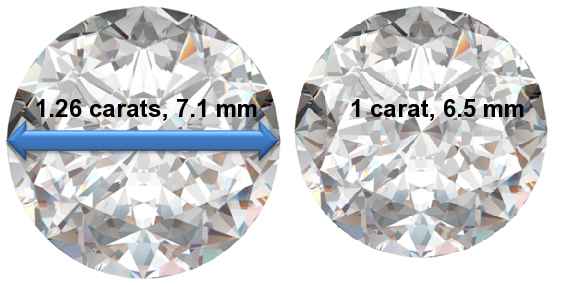Quick and Easy Buying Guide
Carat weight: 1 carat = 200 milligrams = 6.5 mm diameter. Doubling weight doesn't double diameter.
Diamond clarity: FL/IF/VVS/VS = super expensive, near perfect. SI = best value if you can check a photo for obvious inclusions (defects).
Color: D-G = colorless, expensive, only if you have money to burn. H-J = best value. Can go lower in gold metal settings than white metal.
Cut: Better cut ratings let more light into a diamond, making it sparkle more. Very important property, don't skimp here.
Set a budget and minimum cut (Premium). Go J color for gold and I/H for white metals. Go searching for SI1/SI2 clarity diamonds at James Allen. Pick a diamond with small/no inclusions. Choose a ring setting and buy it risk-free (60-day returns).
1.26 Carat Diamonds
Each carat in a diamond is equivalent to 200 mg, so this 1.26 carat diamond weighs 252 mg. The diameter of a 1.26 carat diamond is approximately 7.06 mm.
Sponsored Links
Some online retailers provide, amongst other diamond properties, a property called the cost per carat, which gives consumers another way of thinking about the value of a diamond.
There are hundreds of thousands of diamonds available online, which can be quite a daunting prospect if you're trying to narrow your choices down. One tip is to add another property of the diamond to the phrase that you're entering into your web browser - you could enter vs1 clarity alongside 1.26 carat diamonds. Remember while the diamond may disappear into insignificance compared to a man's hand, women generally have significantly smaller hands with thinner fingers - the diamond will appear a lot larger when placed on their hand.
I used to dream how good it would be to be Willie Mays or Mickey Mantle. My dreams have died. Even the rotten rings aren't what they're supposed to be. I'll buy my own diamonds. I can afford it now. No one gives you anything, you've got to get it for yourself. Reggie Jackson .

Ever looked at a similar carat size of diamond and another gemstone and wondered why the stones appeared so different in size? This is undoubtedly because different types of stones have different specific gravity densities, leading to this discrepancy in size. There are no firm statistics that are universally applicable, but it is generally agreed that the average size of a diamond is around a third of the carat, perhaps a little more.
A large diamond which has a huge crack down the middle, or alternatively a big yucky looking inclusion, is not a good look - it looks like someone has gone for size and sacrificed all the other desirable properties of the diamond. Clarity, for example, can be just as important in picking a diamond.

